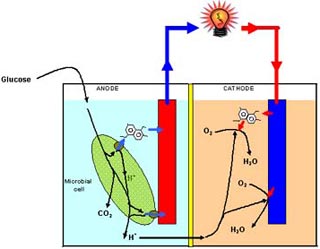Producing high energy fuel cells from cows
Thanh Van
According to researchers at Ohio State University, one day it will be possible to meet an increasing demand for alternative energy sources. They used microbial fluids from a cow to generate electricity in a small fuel cell.
The new bacterial cell is a redesign of a larger model created a few years ago. The new cell is one-fourth the size of the original model, but can produce up to three times more energy, trainee, Dr. Rismani-Yazdi specialized in Ohio University biotechnology and agriculture. State said.
Experiments show that just these two new cells can produce enough electricity to charge an AA-sized battery. If using the first generation fuel cells, it would take up to four new cells to charge one of these batteries.

A type of fuel cell.
(Photo: microbialfuelcell)
Mr. Rismani-Yazdi is the main researcher on cellulose-based bacterial fuel cells. The energy source for fuel cells comes from the breakdown of cellulose caused by a variety of bacteria in rumen fluid, a microbial fluid found in the cow's rumen, the largest in the cow's stomach. To generate energy, researchers fill a compartment of bacterial fuel cells with cellulose and rumen fluid.
'Energy is generated when bacteria break down cellulose, one of the richest compounds on our planet,' said Rismani-Yazdi. In fact, cellulose is abundant in most farms, because harvesting often leaves a lot of cellulose in the form of plant residues. Other rich cellulose sources are waste paper or wood articles.
Mr. Rismani-Yazdi and his colleagues are continuing to refine their microbial fuel cells, as well as trying to find a way to feed a large number of rumen bacteria in the laboratory to be able to use it on a large scale. Future.
The team collected rumen fluid from a live cow, draining the fluid from a probe. Then they filled a compartment of fuel cells with this cellulose and microbial fluids.
Bacterial fuel cells have two compartments with a width of about 2 inches, high and long about 3 inches. A thin film made of special material prevents the two compartments. This material allows the proton to move from the negative (anode) compartment to the positive (cathode) compartment. The protons, electrons moving through the wire and the resistor connecting the two compartments will create an electric current.
A small piece of graphite is placed in each compartment that acts as the fuel cell's electrode. Researchers filled the anode chamber with cellulose and bacteria from rumen fluid, electrons escaping when microorganisms break down cellulose. These electrons are then transferred to the anode electrode.
The researchers filled the other compartment, the cathode compartment, with potassium ferricyanide, a chemical that acts as an oxidizer, helping to close the circuit by receiving electrons from the cathode electrode. Once the circuit is closed, the electron moves from the anode to the cathode, and results in electricity.
Microbial fuel cells with the least resistance produce the most energy - enough to run a light on a miniature Christmas tree, which is three times as much energy as a generation of fuel cells. Firstly.'The amount of electricity we get from one of these cells is basically related to the resistance of the object we want to power,' said Rismani-Yazdi.
He said he used to add cellulose to fuel cells every two days, although this amount may vary depending on how quickly the energy is removed from the cell.
'But the power capacity of these fuel cells is stable indefinitely as long as we keep feeding bacteria cellulose,' said Christy associate professor of biotechnology, agriculture and food. 'We tried running these cells within 3 months.'
Although the technology is still in its infancy, researchers are encouraged by what they have done in the past two years and they are continuing to work hard to increase the amount of electricity that the cells use. This bacterium can be produced.
- Produce fuel from cow's belching gas
- Fuel cells allow drone to fly for hours without charging
- Turn solar energy into liquid fuel
- Singapore develops premium fuel cell materials
- Molecular stimulation enhances the performance of energy cells
- Japan: Fuel cell 'crowned'
- Treatment for diabetes with drugs
- New technology allows solar cells to be more colorful
- Bio-robots run by energy from urine
- Solar cells will be usable at night
- Robots can eat for energy like humans
- US research creates heat-resistant cows for future food
 Why do potatoes have eyes?
Why do potatoes have eyes? 'Tragedy' the world's largest carnivorous life: Death becomes ... public toilet
'Tragedy' the world's largest carnivorous life: Death becomes ... public toilet Tomatoes were once considered 'poisonous' for 200 years
Tomatoes were once considered 'poisonous' for 200 years Detecting microscopic parasites on human face
Detecting microscopic parasites on human face